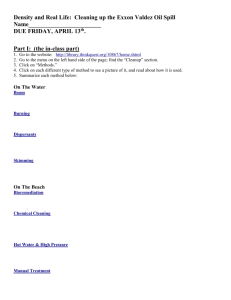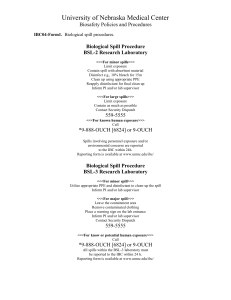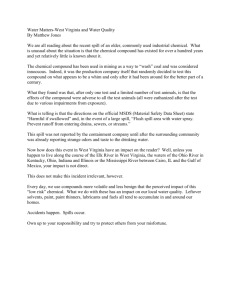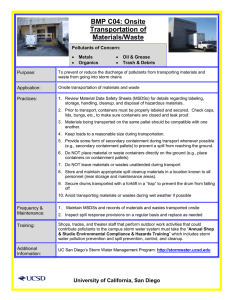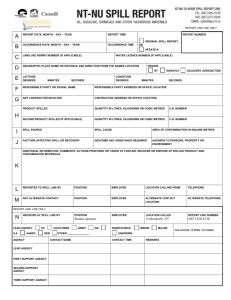Oil Spill Lesson Plan
advertisement
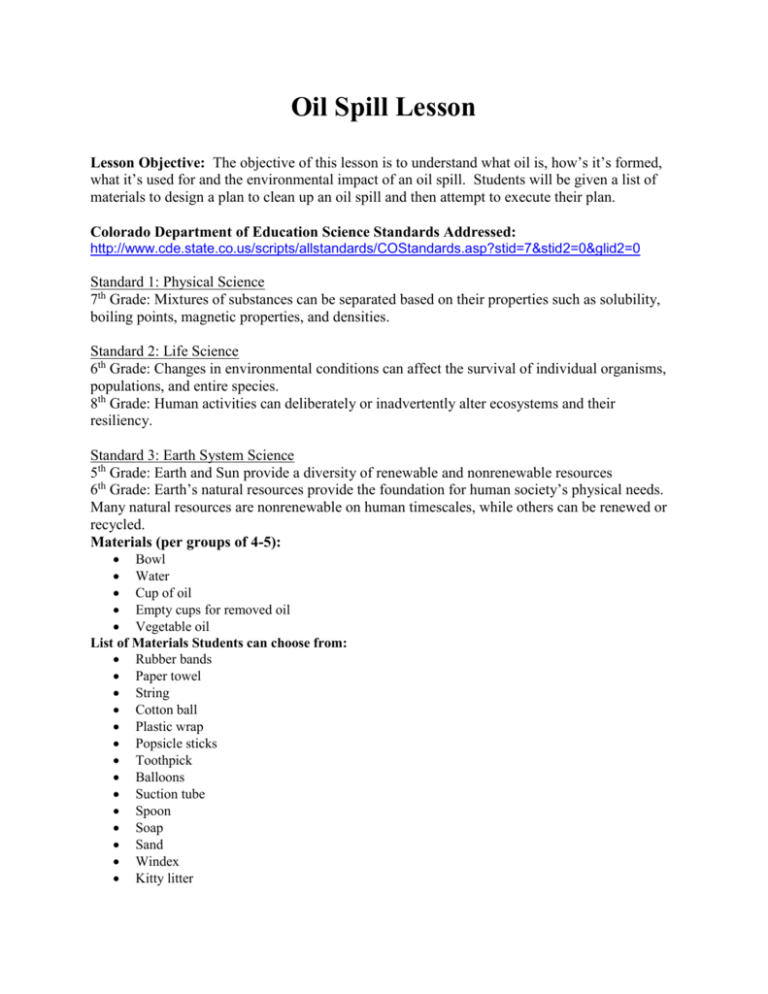
Oil Spill Lesson Lesson Objective: The objective of this lesson is to understand what oil is, how’s it’s formed, what it’s used for and the environmental impact of an oil spill. Students will be given a list of materials to design a plan to clean up an oil spill and then attempt to execute their plan. Colorado Department of Education Science Standards Addressed: http://www.cde.state.co.us/scripts/allstandards/COStandards.asp?stid=7&stid2=0&glid2=0 Standard 1: Physical Science 7th Grade: Mixtures of substances can be separated based on their properties such as solubility, boiling points, magnetic properties, and densities. Standard 2: Life Science 6th Grade: Changes in environmental conditions can affect the survival of individual organisms, populations, and entire species. 8th Grade: Human activities can deliberately or inadvertently alter ecosystems and their resiliency. Standard 3: Earth System Science 5th Grade: Earth and Sun provide a diversity of renewable and nonrenewable resources 6th Grade: Earth’s natural resources provide the foundation for human society’s physical needs. Many natural resources are nonrenewable on human timescales, while others can be renewed or recycled. Materials (per groups of 4-5): Bowl Water Cup of oil Empty cups for removed oil Vegetable oil List of Materials Students can choose from: Rubber bands Paper towel String Cotton ball Plastic wrap Popsicle sticks Toothpick Balloons Suction tube Spoon Soap Sand Windex Kitty litter Background: Oil and natural gas (methane) are nonrenewable resources. Some students maybe familiar with natural gas as they use for their kitchen stove in their house. Oil and natural gas are formed from small, dead ocean organisms that sink to the bottom and get covered by layers of rock and dirt. Over millions of years, the remains get buried deeper and deeper, eventually heat and pressure turn the remains into oil and natural gas. When oil is removed from the ground, it comes out as a mixture of different compounds. These compounds can be separated based on their boiling point (called distillation). Thus oil can be used for many purposes such as: fuel (gasoline, jet fuel, kerosene, and diesel), asphalt, lubricants, plastic production and other chemicals. Because oil is not found everywhere, once it is drilled out of the ground it must be transported. This transporting of oil leads to the danger of oil spills, whether it is a crack or a leak in a pipeline or when an oil tanker wrecks. Various methods can be used to clean up an oil spill. These methods include: bioremediation (using microbes to digest the oil), dredging (some oils sink, cleaning below the surface of the water), skimming (cleaning oil off of the surface), dispersion (materials, such as some detergents can disperse oil into small clusters that may be easier to remove than larger areas), and burning (can eliminate large amount of oil in the water, but causes air pollutions). Environmental engineers must consider all of these factors in containing and cleaning up an oil spill. Lecture: Talk to students about oil: where it comes from, how it’s made, what it is used for. Discuss that oil is not found everywhere and needs to be transported, which can lead to oil spills. Briefly discuss some methods that are used to clean up an oil spill. Activity Procedure: Divide students into groups of 4-5. Hand out the planning worksheet and write the list of materials on the board. Have student write out their plan for both containing the oil spill and cleaning up the oil. Students must list specifically how much of the materials they want (ie. how many cotton balls). Give students their materials. Give them a few minutes to set up. Give each group a bowl of water and an empty up for the oil they remove. Walk around and pour in a small cup of cooking oil into the bowl of water. Once you are done pouring, they can begin their containment and cleanup process. Give students about 15 minutes to work on the cleanup. Discussion afterwards: there is no right answer, the idea is for students to see how difficult it is to clean up an oil spill and to design a plan and try to execute it. Follow up questions can include: What worked? What didn’t work? If you had to do it again, what would you change? Did you stick to your original plan? What other materials would have been helpful? Prepared by: Nick Stambach Developed with: Courtney Nelson Reference http://www.tryengineering.org/lessons/spillsolutions.pdf Planning Sheet List of materials to use for containment Write out your containment strategy List of materials used in clean up Write out your clean up strategy
